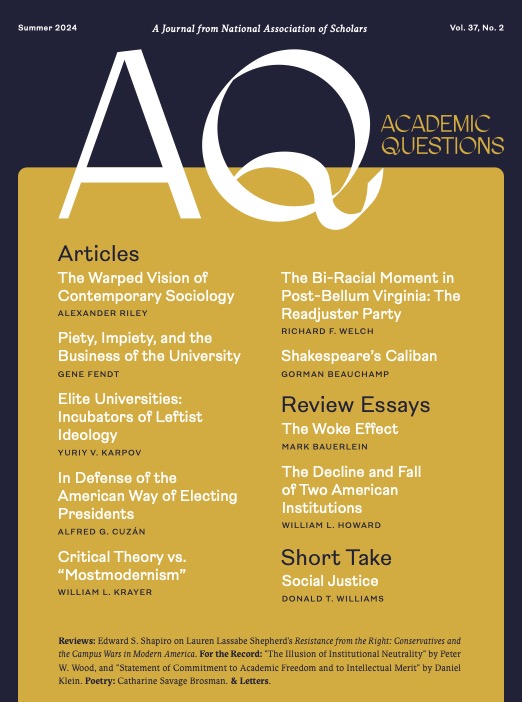There is one Caliban, only one Caliban, the one in Shakespeare’s play. The legion of others appropriating his name—wannabes, burlesques, poseurs, satirical degradees, the wretched of the earth of various times and places—are pseudo-Calibans, extra-Shakespearean. I mean by this that the only accurate description of Caliban’s actions and meaning are those found in The Tempest and demonstrable on stage. That excludes the vast plethora of what has been written about him, both in much Shakespearean criticism and, even more so, in the Third World screeds that have glommed onto their distortion of him as a symbol.
Certainly Caliban, like Falstaff and Shylock, has escaped his play, looming larger in the afterlife. One need not begrudge this celebrity; indeed, two books that I know of treat it in remarkable detail: Albert T. and Virginia Mason Vaughn, Shakespeare’s Caliban: A Cultural History (1991) and Chantal Zabus, Tempests After Shakespeare (2002). But, in fact, neither deals primarily with the character found in Shakespeare’s play. Let me jump immediately to the most extreme example to show what I mean, Amie Cesaire’s Une tempete. The indefinite article of his title indicated that he was, he said, writing a variant of Shakespeare’s play; in fact, it was a complete inversion, a refutation: “nothing was left of Shakespeare,” Zabus writes. To call it an “adaptation” of The Tempest for a New World audience, as one writer has, is to abuse the word adaptation. Most of Shakespeare’s characters are gone or greatly diminished, others added, Caliban elevated to hero, the “colonial enterprise” defeated, and Prospero, who stays on the island, revealed a bitter and broken old man. How’s that for an adaptation? Marcel Duchamp’s putting a mustache on the Mona Lisa comes to mind. Or the Marx Brothers parodying Il Trovetore in Night at the Opera, although Night at the Opera is a work of genius, which Une tempete decidedly is not. If one’s progressive politics outweighs his aesthetic sensibilities, then Cesaire’s play should be just the thing for him: they’d deserve each other, The Tempest reserved for their betters.
My point suggests that most of the political revaluations of Caliban tend finally toward Une tempete. But much of the academic “criticism” is relatively harmless professorial crocheting: who were Caliban’s sources, how did he get his name, what exactly did he look like? None of these are asked in the play—nor answered. In 1933 L. C. Knight published an essay with the wonderful title, “How Many Children Had Lady Macbeth?,” a send up of the quest for biographical information about Shakespeare’s characters not found in the plays. An earlier, less tongue-in-cheek effort was Mary Cowden Clark’s The Girlhood of Shakespearean Heroines, which posited prequels for them. While such studies had fallen, more or less, into disrepute, Caliban’s critics seem not to have heard—or cared. The Vaughns devote a couple of lengthy chapters to assaying the various answers given to these stage-irrelevant questions, e.g., how many prototypes had Caliban? Coleridge, in his Preface to Christabel, noted something relevant here: “For there is amongst us a set of critics, who seem to hold, that every possible thought and image is traditional; who have no notion that there are fountains in the world… and would charitably derive every rill they see flowing, from a perforation made in some other man’s tank.”
Ah, yes, so many rills from so many tanks sloshing around Caliban. But the Vaughns quote a near contemporary of Shakespeare’s, Nicholas Rowe, who provided the only answer needed: “Caliban shews a wonderful Invention in the Author, who could strike out such a particular wild Image, and is certainly one of the finest and most uncommon Grotesques that ever was seen.” Or Joseph Addison who affirmed it showed “a greater genius in Shakespeare to have drawn his Caliban” than any of his historical characters,” for it was supplied out of his own imagination,” not historical accounts.
Similarly we have no reason not to believe that the name Caliban—like Dogberry or Peaseblossom or Doll Tearsheet—was the coinage of his own fertile imagination. Certainly extremely rare has been the theater-goer who sat through a production of The Tempest wondering about the origins of the nomenclature. Occam’s razor should work here. Ditto for Sycorax (Caliban’s dam, a witch).
If we approach The Tempest more or less seriatim, we can see what is actually in the play versus what is fanciful, usually false accrual. The setting: the little island of the action is somewhere in the Mediterranean Sea. The King of Naples and his court are returning to Naples from Tunis where his daughter has wed the king; the way is across the Mediterranean, not with stops in the Bahamas or in Virginia along the way. A whole school of critics have argued that Shakespeare was writing about the New World, literature of its discovery published more or less the same time as the play’s composition: Shakespeare must have known it, they contend, one claiming he must have had this literature on his desk as he wrote. Nothing in the play suggests that; no one knows what Shakespeare knew about that literature of the New World, nor even less what his Globe audience would have had to know in order to catch his allusions (if there were any). If Caliban were an American Indian, he would have to appear with a tomahawk and war bonnet to let the audience know: he doesn’t. The one reference to the New World—Ariel’s casual reminder that Prospero once “call’dst me up at midnight to fetch dew/ From the still-vexed Bermoothes”—serves only to indicate the range of his abilities, like his counterpart today might boast of having successfully retrieved something from Timbuktu, the edge of the world locale. No, the critics who would have The Tempest a tale, often proleptic, of the English colonizing America are just whistling Dixie.
The matter of colonialization, which comes to loom so large in critical treatments of The Tempest, gets debunked in I. ii., the first scene with Prospero and Miranda. Prospero is telling his daughter how they came to be isolated on this island, not in the least as invaders, but as refugees. Deprived of his duchy of Milan by his younger brother, with the connivance of the King of Naples, he was set adrift with his three year-old daughter in a tub without oar or sail and simply drifts—providentially, he believes—to this location. And he is intent on leaving it as soon as possible—thus the storm he magically arranges to get them repatriated to Italy.
Increasingly in the criticism Prospero has come to be considered the prototypical colonial settler, a critical part of what is called “the deprivileging of Prospero.” Nothing, however, could be farther from the person and situation of the character in Shakespeare’s play. One critic begins a sentence, “As Prospero changes over time . . .” but he doesn’t; he’s just the same today as he was in 1611: the audience may change, the play doesn’t.
This same scene introduces Caliban—and a host of questions. One that the play does not answer, and that intrigued people from the outset, concerns his appearance—what does he look like? Neither a tortoise (as per Prospero, for his slowness) or a fish (as per Stefano and Trinculo, for his smell), although apparently he’s been staged as both, he has two arms, two legs and a head, albeit somehow defective. Some deformity, that is, identifies him as a “savage,” but not further specified. The fact that he is also called a “slave” has hardened into his being, more or less universally, a Negro. Canada Lee in Margaret Webster’s 1945 Tempest on Broadway apparently broke the color barrier to mixed reviews, but began the racial hegemony for casting that role. Look up Caliban on Google and it says simply Black African. That’s three-fourths wrong: his mother Sycorax is North African (Algerian) not of the sub-Saharan coloration; his father is a devil, mentioned once as Setebos, evil deity of the Patagonians, a South American people, dark but not black. “This thing of darkness,” that Prospero acknowledges, can, but need not necessarily, be played by a black man. Given how stupid and evil he is—of which, more later—it surprises that black actors, many of whom shun Othello as too gullible, would want to play him, most likely due to his elevation in modern productions as the plays center, his nastier edges shaved away. In her recent The Great White Bard: How to Love Shakespeare While Talking About Race, Farah Karim-Cooper discusses how an Anti-racist Webinar on The Tempest in 2021 dealt with the fact that black men usually played Caliban: the suggestion for directors who want to decolonize the play more overtly: “Undercut the ‘foulness’ by staging its opposite. Cast a beautiful actor.” Idris Elba as the monster? Might be good box office, but would be sabotaging Shakespeare—intentionally, of course.
This scene, where we first see Caliban, conveys a lot of narrative quickly: how his witch mother, banished there, bore him and died, leaving him the sole inhabitant of the island (although hardly an indigene); how Prospero and Miranda found and first tendered him—"And then I loved thee/ And showed the all the qualities o’ th’ isle” —and kept him in their home; and how he betrayed their trust when “thou did seek to violate/ The honor of my child.” Again, as part of “the deprivileging of Prospero” of modern postcolonial criticism, the very words he speaks are questioned for their accuracy, as here with “Prospero’s charge that Caliban tried to rape Miranda.” I am at a loss what to make of this. Of course, characters lie or dissemble all the time in Shakespeare; Prince Hal and Iago go through their whole plays lying but tell us that that’s what they are doing. There is no sense here or anywhere else in The Tempest that Prospero is being untruthful: one, now, may not like all he has to say, may find it disagreeable, but he is not lying. As is proved by Caliban’s gleeful reply:
O ho, O ho! Would it had been done!
Thou didst prevent me; I had peopled else
This isle with Calibans.
And there is Miranda’s reinforcement: “Abhorred slave/Which any print of goodness will not take,/ Being capable of all ill.” Whatever our postmodernists will want to make of this, can we doubt that for the original Globe audience Caliban has just been nailed for what he is, a rapist wannabe? In the era of #Me Too awareness, hyperalert to sex crimes, Caliban’s serial rapist proclivities should seem especially odious, particularly given Miranda’s affirmation: for as today’s mantra runs “girls should always be believed.” She even taught him how to speak human language, and “my profit on’t/ Is,” he replies, “I know how to curse.” We know the type.
Their slave, Caliban is sent off, cursing, to fetch wood, and the action turns to the really important matter of the play, the storm, how and why Prospero caused it and its consequences. (Caliban is not actually the play’s focus.) We meet Ariel, the swift-winged spirit who is the agent of all Prospero’s white magic, he who causes the actually harmless storm that brings the King of Naples and his court to Prospero’s control on the island. In his own beguiling way, he stands in contrast to the cloddish Caliban, devoted to Prospero but longing to be free. In the shipwreck, Prince Ferdinand is separated from his father’s court, each assuming the other had perished. His grief, however, is much assuaged by the sight of Miranda with whom he instantly falls in love, as she, instantly, with him. This is, after all, a fairy tale—one character, seeing the strange events on the island, confesses, “Now I will believe/That there are unicorns”—in which, perhaps, he never loved who loved not at first sight. In any event, their plot line begins, his efforts to woo and wed her.
In another part of the island King Alonzo laments the supposed death of his son, unaware that in his fatigued sleep his brother, thinking the king’s heir dead, begins to plot with Antonio, Prospero’s usurping brother, to follow his example of succeeding his lord by means of a few inches of steel. We have here the elements of a Shakespearean tragedy, not unlike King Lear, but, of course, Prospero’s white magic converts tragic possibilities into comic eventualities (with Ariel’s gentle persuasion): “The rarer action is/ in virtue than in vengeance.” The working out of all these complexities constitutes the third, but main, plot line of The Tempest.
But we are not all done with Caliban. Act II, scene ii probably for many, even most viewers, even its first Jacobean ones, the highlight of the play. Too broad and too extensive to fall under that paltry rubric comic relief, it can have the effect of unbalancing the play with its slapstick. Caliban, seeing a man he takes for one of Prospero’s spirits, falls to the ground hiding under his cloak. The man Trinculo, the King’s jester, saved from the wreck and fearing another storm, takes refuge under the already occupied cloak. Then the King’s butler Stephano enters drunk and drinking—he’d ridden a butt of sack ashore from the storm—to find he’s discovered a monster with four legs, four arms, and two heads and would be a made man if he could get him back to Italy. Confusion follows. The two men recognize each other, speculate on who and what the strange creature is who speaks their language, and begin plying him with liquor. A soon inebriated Caliban thinks Stephano has fallen from the heavens and implores him, “I prithee, be my god.” Trinculo judges correctly when he concludes, “A most ridiculous monster, to make a wonder of a poor drunkard!”
The zaniness, however, takes on a darker aspect when two scenes later Caliban is begging his new “god” to kill his old master: he’ll take Stephano to where he sleeps, “Where thou mayst knock a nail into his head.” As additional incentive, he pimps Miranda to Stephano: “She will become thy bed . . . And bring thee forth a brave brood.” “Monster,” he replies, “I will kill this man.” All this is comic, of course—overheard by Ariel and reported to Prospero—but sets up a parallel to the Sebastian-Antonio plot to kill King Alonzo, one potentially tragic, the other entirely farcical. But in their last scene, when the jester and butler are distracted by the rich clothes Prospero has set out to tempt them, Caliban remains intent on his crime: “Let alone, And do the murder first.” Instead they are run off by hunting dogs through pools of piss. We see Caliban only once more, in the play’s last scene where all are present to hear Prospero’s final dispositions: Caliban is only sent to trim his master’s cell. His response, proper for comedy:
I will be wise hereafter
And seek for grace. What a thrice-double ass
Was I to take this drunkard for a god
And worship this dull fool!
I have wanted to show Shakespeare’s Caliban as he appears in The Tempest, as “disproportioned in his manners/ As in his shape.” “A devil, a born devil, on whose nature/ Nurture can never stick.” His comedy, while very imaginative, remains of a low order, and he appears in it only foolish and malicious: nothing much to make a hero of here. The only loose end, unremarked in the play, is that, while all the others evacuate the island to return to Italy, Caliban remains alone, free at last as he wanted, but to do what? There might have been a sequel, a kind of monodramatic Waiting for Godot, but in all the vast writing about Caliban I’ve not seen that. The stage history of The Tempest for the first two hundred years, such as it is, indicates that the grotesque malevolent Caliban held the stage, pretty much as Shakespeare probably intended. Only with the rise of Romanticism early in the nineteenth century did a pathetic, put-upon character emerge, with whose desire for freedom audiences began to sympathize. The changing political zeitgeist of more recent times, the rise of anti-colonialist action and ideology, not only strove to reorient the play, altering and “adapting” it to suit, say, Franz Fanon, but increasingly creating a symbolic Caliban who owed nothing at all to Shakespeare, but much to Toussaint Louveture and Che Guevera. Much of the Vaughns’ book and almost all of Chantal Zabus’s deal with this remarkable, voluminous afterlife of a Shakesperean creation-in-name-only, like cheap imitation designer bags. Both might hold your cash and keys, but hadn’t you rather have the real Gucci?
Gorman Beauchamp is the author of a book on Jack London and essays on subjects ranging from Shakespeare to science fiction; [email protected]. Beauchamp is also an associate professor emeritus of humanities at the University of Michigan. He last appeared in these pages in the summer of 2023 with “Two Good Words for Colonialism: Hong Kong.
Photo by Johann Heinrich Ramberg - Cornell University, Public Domain, https://commons.wikimedia.org/w/index.php?curid=36370003














